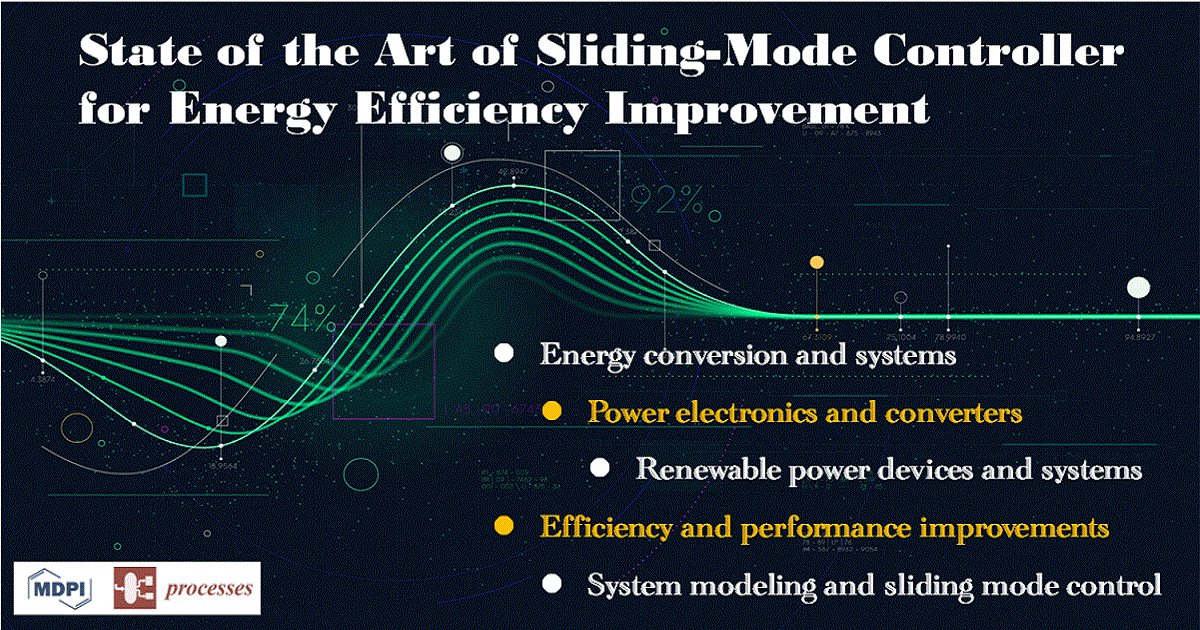State of the Art of Sliding-Mode Controller for Energy Efficiency Improvement
A special issue of Processes (ISSN 2227-9717). This special issue belongs to the section "Energy Systems".
Deadline for manuscript submissions: closed (1 August 2022) | Viewed by 4294

Special Issue Editors
Interests: power converters; motor drives; control systems technology
Special Issues, Collections and Topics in MDPI journals
Interests: AC motor drives and generators; power converters; photovoltaic power systems; micropositioning systems; sliding-mode control and applications
Special Issue Information
Dear Colleagues,
With the demand for energy-efficient power systems growing in many applications, control techniques to improve transient performance or energy efficiency have acquired a particularly important role. Among the available control techniques for control systems, the sliding-mode control (or variable structure control) approach has received much attention in various applications due to its robustness againt disturbances and uncertainties and its superior transient response properties. As a result, numerous studies have been carried out on the applications of (higher-order or advanced) sliding-mode control techniques to improve energy efficiency or transient performance in motor drives, energy storage and supply systems, and power generators and converters.
The aim of this Special Issue on “State of the Art of Sliding-Mode Controllers for Energy Efficiency Improvement” is to present up-to-date research on energy-efficiency-improved power and/or energy conversion systems by controllers, especially advanced sliding-mode controllers. Topics include but are not limited to the following:
- Energy conversion and systems
- Power electronics and converters
- Renewable power devices and systems
- Efficiency and performance improvements
- Sliding-mode controllers
- System modeling and control
Prof. Dr. Hsin-Jang Shieh
Dr. Ying-Zuo Chen
Guest Editors
Manuscript Submission Information
Manuscripts should be submitted online at www.mdpi.com by registering and logging in to this website. Once you are registered, click here to go to the submission form. Manuscripts can be submitted until the deadline. All papers will be peer-reviewed. Accepted papers will be published continuously in the journal (as soon as accepted) and will be listed together on the special issue website. Research articles, review articles as well as short communications are invited. For planned papers, a title and short abstract (about 100 words) can be sent to the Editorial Office for announcement on this website.
Submitted manuscripts should not have been published previously, nor be under consideration for publication elsewhere (except conference proceedings papers). All manuscripts are thoroughly refereed through a single-blind peer-review process. A guide for authors and other relevant information for submission of manuscripts is available on the Instructions for Authors page. Processes is an international peer-reviewed open access monthly journal published by MDPI.
Please visit the Instructions for Authors page before submitting a manuscript. The Article Processing Charge (APC) for publication in this open access journal is 2000 CHF (Swiss Francs). Submitted papers should be well formatted and use good English. Authors may use MDPI's English editing service prior to publication or during author revisions.
Keywords
- energy conversion and systems
- power electronics and converters
- renewable power devices and systems
- efficiency and performance improvements
- sliding-mode controllers
- system modeling and control
Benefits of Publishing in a Special Issue
- Ease of navigation: Grouping papers by topic helps scholars navigate broad scope journals more efficiently.
- Greater discoverability: Special Issues support the reach and impact of scientific research. Articles in Special Issues are more discoverable and cited more frequently.
- Expansion of research network: Special Issues facilitate connections among authors, fostering scientific collaborations.
- External promotion: Articles in Special Issues are often promoted through the journal's social media, increasing their visibility.
- e-Book format: Special Issues with more than 10 articles can be published as dedicated e-books, ensuring wide and rapid dissemination.
Further information on MDPI's Special Issue polices can be found here.






